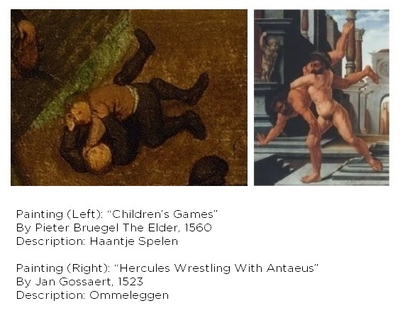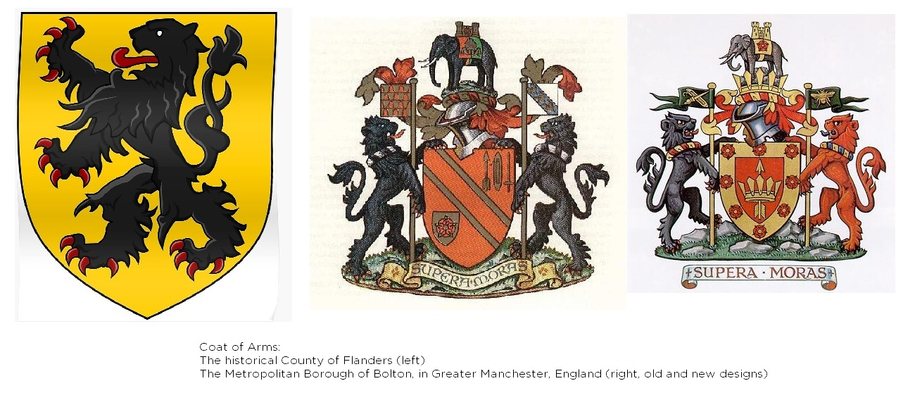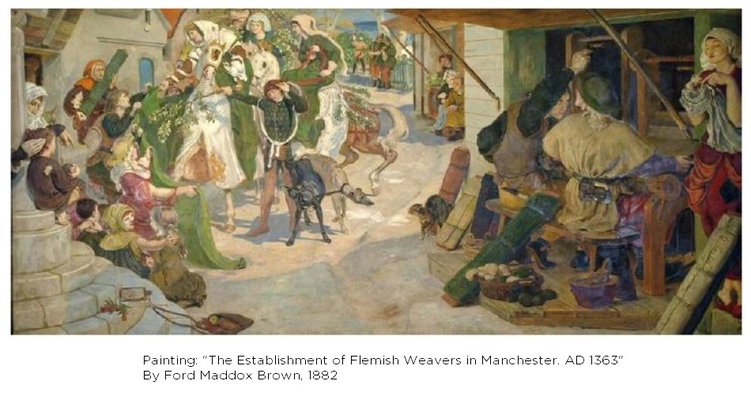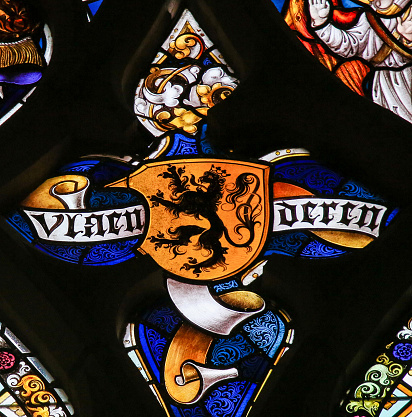Special Thanks To:
Hannelore Franck of Yper Museum, Geert Souvereyns of Musea Brugge, Bernard Pauwels of Kortrijk Erfgoed en Musea, Stephane Debonne, Claude Vandewoestyne of Stedelijke Oudheidkundige Commissie Wervik – Geluwe, the staff of Kortrijk 1302 Museum, Wervik, Beernem and Geluwe Libraries and to my friends Bernard Vandamme of Bruges (Belgium), Paul Lengkeek of Utrecht (Netherlands) and Jannes Huizing of Groningen (Netherlands), also to my friends from Limburg, Belgium, namely Luk Indesteege, Jos Sterk and Karel Velherst of Bibliotheek Hasselt (Limburg, Belgium).
Laat Ons Ne Keer Ommeleggerke Doen, Durf-je?
Let’s Try A Fall (Wrestle), Would You Dare?
Traditional Wrestling Games in West Flanders (Belgium).
In his “Canterbury Tales”, the Father of English literature Geoffrey Chaucer (1343-1400) calls the Flemish knight Sir Thopas of Poperinge (West Flanders, Belgium) an undefeated wrestler: “In wrestling, there was no one his peer.” Why did the author choose a Flemish man to idolize? This is explained by the fact that in Medieval Europe the Flemings were well known for their strength and skill in the ancient art of their traditional freestyle wrestling which featured wrestling on the ground and had no restrictions regarding the holds.
According to the 1905 “Children’s Games in the Flemish Belgium” a book which was released by the Royal Flemish Academy of Language and Literature there were two kinds of traditional free-for-all wrestling games (Vechten, Man Tegen Man, aka Worstelen/Worstelinge, Lijf Tegen Lijf which is a kind of wrestling combat in which everything is allowed but without intentionally hurting each other) in the rural areas of West Flanders, Belgium (the “Land of Chaucer’s Sir Thopas”).
1) Ommeleggen. In the 1892 “Westvlaamsch Idioticon” the word “Ommeleggen” is defined as such “Omkeeren en nederleggen langs den grond”, which means “to flip over (to turn around, to turn upside down) and lay down on the ground.” Another name for that kind of wrestling was - “Overhoop Smijten/Gooien” (literal translation, to throw upside down).
Ommeleggen was a standing (upright) wrestling style in which to win the wrestler had to give his opponent a “complete somersault” on his back (a throw in which “heels go over the head”, and back of the head and neck, and the shoulders come to the ground first) with or without falling down himself. The modern international wrestling terminology refers to such falls as the grand amplitude throws, or the five-point throws.
In this mode of wrestling lifting and throwing techniques played the decisive role. The most commonly used throwing techniques were:
a) Buttocks/Throws over the back (for example headlock into buttock throw) and Crossbuttocks/Throws over the hip (arm-swing hold, headlock/arm around the neck hold, arm around the waist hold),
b) Flying Horse/Fireman Lift,
c) Standing Half-Nelson and Crotch (flip over the head),
d) Flying Mare/Throw over the shoulder,
e) Bear-hug Lift (hold around the waist) which is followed by having opponent on the shoulder and throwing him backwards over his head,
as well as various spectacular pro-wrestling kind of throws such as the “Monkey Flip” (flip over the head, upper arms hold and foot is placed against the abdomen), “Back Body Drop” (flip over the head, hold behind the knees and head is placed between the legs).
The execution of such powerful and artistic throws required certain mastery, deep knowledge and understanding of the game of wrestling which could only be achieved in regular training. This style was a very dangerous form of wrestling and often the outcome of such contests were serious injuries or even the death of one of the participants due to spinal fractures sustained by the wrestlers who landed badly on their backs or heads.
2) Haantje Spelen (Cockfighting Game), an up and down wrestling in which to win the wrestler had at first to take his opponent down, and achieve the “on top” position either by landing on top of him or by placing him on his back during the struggle on the ground, after that he had to maintain this dominant uppermost position (his opponent is underneath him on his back) on the ground for 3 (three) minutes.
Emiel Vliebergh, a Belgian writer, in his 1908 book called “De Kempen”, on Page 40 talks about the fighting/wrestling traditions of Bezembinders of Hasselt, Limburg (Belgium). The Bezembinders or “broom-makers” were a unique community of Limburgish people who in the late 1800s preserved the lifestyle and customs of the “days of old”. According to the author, very often the young, 20-22 year old men among the Bezembinders would take off their clothes, besmear their bodies with oily green soap and wrestle for the honor to be recognized as the strongest man of their group. Those fights were held publicly, the men fought in front of other members of the community who excitedly supported their champions. There’s a good chance that the Bezembinders style of wrestling shared some resemblance with the Haantje Spelen of West Flanders.
Haantje Spelen wrestling game was very similar to the Dutch folk wrestling style called Stoeijen (modern spelling Stoeien). According to the information kindly presented by Mr. Paul Lengkeek the Chairman of the KNKF (Koninklijke Nederlandse Krachtsport en Fitnessfederatie/Royal Dutch Strength Sport and Fitness Federation) the rules of Stoeien wrestling which were passed down through generations as an oral tradition didn’t change much over the centuries. The upper body techniques, grabbing legs and tripping is allowed. The joint-locks and chokes are prohibited due to the jocose nature of the contests (vechten/worstelen uit de grap). The objective is to pin the opponent down with his back flat on the ground until a verbal submission (“Genade – “Mercy” or “Ik geef me over” – “I surrender”).
The wrestling game (stoei) called Ondergooi which was popular among the Dutch people of South Africa (Boers) was similar to Flemish game Haantje Spelen. The description of that game was given by Ernst Jacobus du Plessis in his book called Gister Keer Terug (Return of Yesterday), 1994 and it also appeared in Tydskrif vir volkskunde en volkstaal (Journal of Folklore and Vernacular), Volumes 46-49, 1990. In that game two boys were taking holds of each other and then by using various feinting maneuvers trying to take the opponent down, get on top of him and manage to maintain the uppermost position for as long as possible.
Traditionally the challenge matches in both styles were held in the field in a circle formed by villagers who would cheer their champions on and bet on the winner. The wrestlers were referred to as “fighters” – vechters and the challenge matches were to determine who is the “better man” (probeeren wie het sterkst is). Both games were still played by the local men in the XIX century.
The 1920s article by Edward Vermeulen (1861-1934) of Hooglede (West Flanders, Belgium) called “Een Wrongsje Maken” (“Making A Curd”) gives a great account of the Ommeleggen wrestling match from the 1870s-90s. According to that article in the local slang the unrestrained wrestling (Worstelen, Lijf Tegen Lijf) was referred to as – making the curd.
This descriptive expression stood for the vigorous up and down stirring movement which is required in making the curd, just like in a real free-for-all wrestling match when the bodies of the two are intensely intertwined. In that article the objective of the Ommeleggen wrestling match was defined to “throw the opponent on his back” by “flipping him over”, which was achieved by “lifting the adversary’s body high in the air and slamming him down to the ground with a violent force”.
The author claims that the best fighters came from the vicinity of Houthulst (West Flanders, Belgium), especially from the village of Klerken.
The original articles (in Flemish) from the 1905 book on Flemish children’s games and the English translation thereof will follow this article. These articles provide an expressive, vivid description of the two traditional Flemish wrestling styles.
A painting created by the Dutch and Flemish Renaissance genius artist Pieter Bruegel the Elder (1525-1569) in 1560 titled “Children's Games” depicts Haantje Spelen wrestling among other games which were popular in Flanders during the Middle Ages. It shows two men grappling with each other on the ground, one trying to maintain the dominant uppermost position utilizing a basic pro wrestling pin the Cover (lateral or cross press). Another famous painting by an artist of the same school called Jan Gossaert (1478–1532), the 1523 “Hercules Wrestling With Antaeus”, shows the Ommeleggen throw which in this case is the most classic pro wrestling Crotch Hold and Bodyslam.

Notably, in the XIV century both Flemish wrestling games were brought to the Salford and Blackburn Hundreds of Lancashire County, England by the Flemish immigrants who were invited to England by King Edward III (1312-1377), who was married to Princess Philippa of Hainault with Flemish ancestry since 1328. Arrival of the Flemings largely influenced the growth and rise of the textile industry in that region of England. The textile workers from Flanders (aka Flemish weavers) at first settled in the vicinity of the town of Bolton, Lancs, that happened in 1337.
Thus for a very long time in East Lancashire Flemish Haantje Spelen wrestling game was known as the “Bolton Method”, or “feightin after the Lancashire fashion, up and down feightin”. Just like in Medieval Flanders in East Lancashire the wrestlers were often called “fighters”, or to be more precise the “up and down fighters.”
On the coat of arms for the Metropolitan Borough of Bolton, we still see the “Black Lion of Flanders” as one of the shield supporters. The heraldic lion holds a banner with an image of a shuttle on it which represented the weaving industry.

In 1363 the community of Flemish weavers was established in the city of Manchester, Lancs. Even in the early 1850s in England outside East Lancashire the Lancashire style of wrestling was still known as the “Manchester wrostlin.”

For centuries Lancashire wrestling just like its direct ancestor Flemish freestyle wrestling existed in two modes: standing (upright) wrestling for a throw (“Well, awl just have thee one thrut/throw for love”, 1827 wrestling challenge in Crompton, Borough of Oldham, Lancs), and up and down wrestling for dominance and control on the ground (“There’s not a man in the room who can hold me down on the floor for five minutes”, 1836 wrestling challenge at the “Golden Lion” pub, Middle Hillgate, Stockport, historically in Cheshire, now in Greater Manchester).
In the first half of the XIX century these two wrestling games were united into one wrestling style - the Lancashire catch-as-catch-can wrestling - which is an up and down freestyle wrestling for the fair back fall. According to the first official written ruleset of Lancashire catch-as-catch-can issued in 1856 by the proprietor of Snipe Inn Grounds (Audenshaw, Lancs), Mr. Nelson Warren, the fair back fall was defined as “two shoulders striking the ground together (simultaneously) no matter how quickly it may occur (even for a brief instant) to the satisfaction of the referee.” The modern international wrestling terminology refers to such falls as the touch-falls.
© 2021 Ruslan C Pashayev All Rights Reserved.
Koninklijke Vlaamsche Academie voor Taal- en Letterkunde
KINDERSPELEN UIT VLAAMSCH BELGIE
Gent, 1905
Ommeleggen, Game № 81 (Pages 64-65)
Pier is een kloeke, streusche jongen, die vóór en na de school menigen maat, in het zand heeft doen bijten. Jan is van eenen en denzelfden deeg gekneed. Elk loft en stoft op zijne macht en vechterskracht. Wij zullen eens meten wie dat er de meeste macht heeft, zeggen ze alzoo, en ze vliegen malkaar in 't haar en werken en wroeten, elk van zijnen kant, om den tegenstrever «omme te leggen», d. i. op den grond te werpen ; alles in vriendschap en minne, zonder nijd of veete, zonder malkaar pijn te doen, zuiver uit leute, om te weten wie meest macht heeft. Men stekt (1) malkaar bij het hoofd, bij de schouders, in de lenden; men werkt met handen en voeten, met hoofd en armen en beenen ; men plooit en wordt geplooid; dwingt en wordt gedwongen; men krult en wringt, men zwoegt en pijnt, totdat een der twee op den grond ligt uitgestrekt en overwonnen is. Onnoodig te zeggen, dat de andere kinders eenen juichenden en joelenden kring vormen rond de «ommeleggers», welke ze met woorden en gebaren ophitsen.
Te Gheluwe : «Ommeleggerke doen ».
(1) Stekken = vast nemen.
Pier is a stout, sturdy boy, who before and after school made many of his mates bite the dust in wrestling matches. Jan, on the other hand, has been cast in the same mould. Both are always bluffing and boasting about their physical strength, and fighting capabilities. “Let us meet and arrange a contest to see who is the strongest”, they say. Immediately they attack one another and wrestle hard, trying to flip the other over on his back i.e. to throw him on the ground; all in a friendly way of course; without hatred or malice, without hurting each other. They grasp each other by the head, the shoulders, in the loins area. They are working with their hands and feet, with head and arms and legs, they force, push, even wrap themselves round the other, leaning over, pulling backward and forward, toiling and paining one another until one of them is lying stretched out on the ground and is defeated. It is needless to say that the other children, the bystanders, make a circle around the fighters and tease them gesticulating, cheering, screaming and roaring.
Haantje spelen, Game № 15 (Page 14)
«Haantje spelen» is eenvoudiglijk eene nabootsing van de welgekende hanegevechten of hanekampen. De knapen staan in eene ronde. Twee van hen kiezen hunne vechters uit. Deze dragen in 't spel den naam van «hanen»; zij treden in den kring, en man tegen man vechtende, trachten ze malkaar «omme te leggen (zie dit spel). De «vechter» die drie minuten onder ligt, is verloren. Evenals op de peerdeloopen en de hanekampen, wordt er op de «vechters» in den kring door de omstaande kinders gewed.
This game (Haantje spelen) is simply an imitation of the well-known game of “cockfighting”. The boys are making a circle. Two of them are selected to be the fighters. They are the “cocks”. They enter the ring and in a man-to-man fight they try to throw the other on his back (see Ommeleggen game). The one who is kept underneath on his back for 3 minutes loses the game. Like in horse-racing and cock- fighting, the bystanders can bet on one of the fighters.
© 2021 Ruslan C Pashayev All Rights Reserved.
Article’s Cover Image: Stained Glass window depicting the Flemish Lion and the text Vlaanderen (Flanders) in the Cathedral of Saint Bavo in Ghent Flanders Belgium, XVI c.


